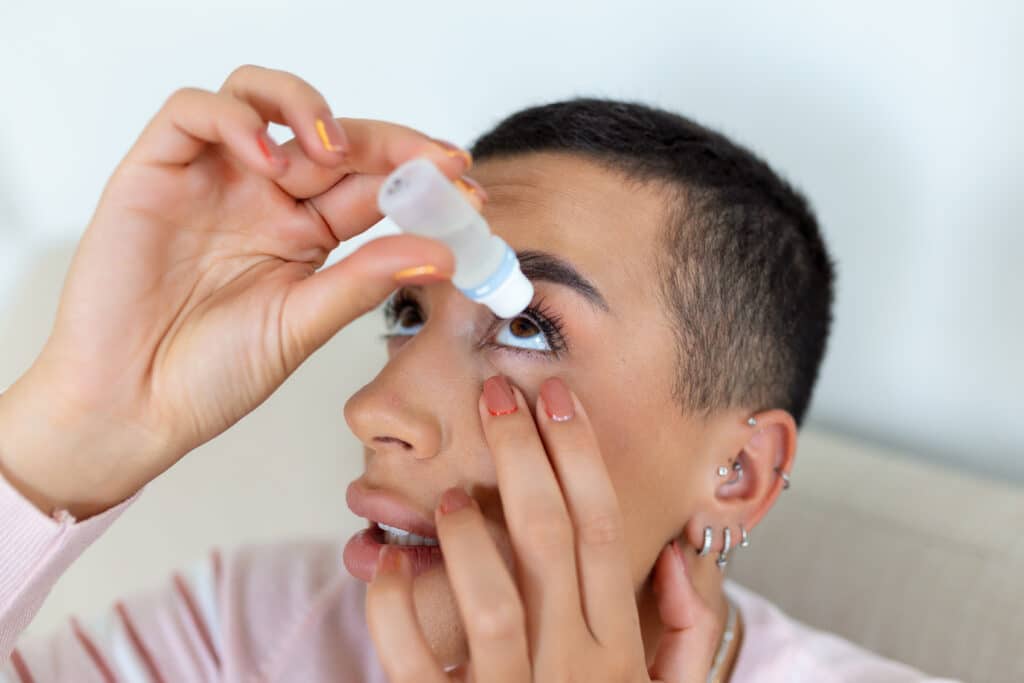Pink eye, also known as conjunctivitis, is a common eye infection that occurs due to inflammation of the conjunctiva. The conjunctiva is the thin, transparent tissue that covers the white part of the eye, and inflammation can be caused by various factors such as bacteria, viruses, allergies, and irritants. This condition can cause red, itchy, and swollen eyes, as well as watery discharge and blurred vision. Fortunately, pink eye can be treated using various types of eye drops, which are available over the counter or prescribed by a doctor, depending on the severity of the infection.
Pink eye drops are a popular treatment for the condition, designed to relieve the symptoms and speed up the healing process. These drops contain various active ingredients, depending on the type of infection and the severity of the symptoms. For bacterial conjunctivitis, antibiotic eye drops are the treatment of choice. These drops work to kill the bacteria causing the infection, and can usually clear up the infection within a few days. For viral conjunctivitis, antiviral eye drops may be prescribed, while steroid eye drops can help reduce inflammation and redness caused by allergies or irritants.
When using Antibiotic Eye Drops for Pink Eye, it is important to follow the instructions carefully and consult with a doctor or pharmacist if symptoms persist or worsen. It is also important to be mindful of potential side effects or interactions with other medications. With proper use and care, pink eye droplets can be an effective and convenient treatment for conjunctivitis.
What are Pink Drops for Eyes?
Pink eye, also known as conjunctivitis, is a common eye infection that causes inflammation and reddening of the eye. While there are various causes of pink eye (including viruses, bacteria, and allergens), it is typically characterized by discomfort, itchiness, and redness.
Antibiotic Eye Drops for Pink Eye are topical medications that are specifically formulated to alleviate the symptoms of conjunctivitis. These drops can be purchased over-the-counter or prescribed by a physician, and are available in a variety of formulations.
What does Pink Eye look like?
Pink eye, also known as conjunctivitis, is an inflammation of the conjunctiva, the thin, transparent layer of tissue that lines the inner surface of the eyelid and covers the white part of the eye. The appearance of pink eye can vary depending on the underlying cause (viral, bacterial, or allergic) and the severity of the inflammation. However, some common signs and Pink Eye symptoms include:
- Pink or Reddish Color: The most characteristic symptom of pink eye is the pink or reddish discoloration of the white part of the eye (sclera) and the inner eyelid. This redness is often the result of dilation and congestion of the blood vessels in the conjunctiva.
- Watery or Discharge: Pink eye may cause excessive tearing (watery eyes) as the body’s natural response to inflammation. In some cases, there may also be a thick, sticky discharge that can cause the eyelids to stick together, especially upon waking in the morning.
- Itching or Irritation: It often causes itching or irritation in the affected eye(s). This discomfort may range from mild to severe and can be exacerbated by rubbing or touching the eyes.
- Gritty Sensation: Some individuals with pink eye may experience a gritty or sandy sensation in the eye, as if there is a foreign object present. This sensation may result from irritation of the conjunctiva or the presence of discharge.
- Swelling: Swelling of the eyelids or conjunctiva may occur in cases of severe inflammation. The eyelids may appear puffy or swollen, and there may be noticeable swelling around the eyes.
- Sensitivity to Light: Pink eye can cause increased sensitivity to light (photophobia), making it uncomfortable to be in brightly lit environments. Individuals with pink eye may prefer dim lighting or may need to wear sunglasses indoors.
- Crusting of Eyelids: In cases of bacterial conjunctivitis, there may be crusting or matting of the eyelashes and eyelids, particularly upon waking in the morning. This is caused by the accumulation of discharge that dries overnight.
How Do Pink Eye Droplets Work?
Pink eye droplets work by delivering medication directly to the affected area of the eye, which can help to reduce inflammation, itching, and discomfort. The exact mechanism of action can depend on the specific formulation, but most drops work by:
– Reducing inflammation: Many pink eye droplets contain anti-inflammatory agents, such as steroids or non-steroidal anti-inflammatory drugs (NSAIDs), that can help to reduce swelling, inflammation in the eye, and Pink Eye symptoms.
– Antimicrobial effects: Some eye droplets for pink eye may contain antimicrobial agents (such as antibiotics or antivirals) that can help to treat the underlying infection causing pink eye.
– Lubrication: Some eye drops contain lubricating agents that can help to relieve dryness and discomfort in the eye.
Are Pink Eye Droplets Effective?
The effectiveness can depend on a variety of factors, including the cause and severity of the infection. In general, however, it can be effective in alleviating the symptoms of conjunctivitis and helping to treat the underlying infection.
It is important to note that not all cases of pink eye require medication and that some cases may clear up on their own. Your healthcare provider can help determine if pink eye droplets are necessary for your specific case.
How To Use Pink Eye Droplets?
It is important to use the eye drops for Pink Eyes as directed by your healthcare provider or as indicated on the product label. Always wash your hands thoroughly before and after using eye drops.
To use, follow these steps:
- Tilt your head back and pull down your lower eyelid to create a small pocket.
- Hold the dropper above your eye and gently squeeze the prescribed amount of drops into the pocket created by your lower eyelid.
- Close your eye and gently press your finger against the inside corner of your eye (near your nose) for 1-2 minutes. This can help prevent the medication from draining out of your eye.
- Repeat these steps for your other eye, if necessary.
When To Use Pink Eye Droplets?
These eye drops may be recommended if you are experiencing symptoms of conjunctivitis, such as redness, itching, and discomfort. In addition, it may be necessary if you have been diagnosed with a bacterial or viral infection that is causing pink eye.
It is important to note that not all cases of pink eye require medication and that some cases may clear up on their own. Your healthcare provider can help determine if pink eye droplets are necessary for your specific case.
What Are The Side Effects Of Eye Drops to treat pink eyes?
Like all medications, these eye drops can have side effects. The specific side effects can depend on the specific formulation of the drops. Common side effects can include:
– Mild burning or stinging sensation in the eye
– Redness or itching in the eye
– Watery eyes
– Blurred vision
If you experience any severe or persistent side effects from pink eye droplets, contact your healthcare provider immediately.
Can I Use Pink Eye Droplets For Allergies?
It may be used to alleviate symptoms of eye allergies, such as itching and redness. However, it is important to note that not all types of eye drops are effective for allergies. Be sure to read the product label and speak with your healthcare provider to determine the best treatment for your specific case.
What Are The Best Eye Drops to prevent Pink Eyes?
The best eye drops for Pink Eyes can depend on the cause and severity of the infection. Some popular brands include:
– Visine-A Multi-Action Eye Allergy Relief
– Similasan Pink Eye Relief Drops
– Bausch + Lomb Alaway Antihistamine Eye Drops
It is important to note that not all cases of pink eye require medication and that some cases may clear up on their own. Your healthcare provider can help determine if the eye drops are necessary for your specific case.
How Long Do Pink Eye Droplets Take To Work?
The time it takes to work can depend on the cause and severity of the infection. In general, however, most eye drops for pink eyes can take a few days to a week to start alleviating symptoms.
It is important to use the eye drops as directed by your healthcare provider or as indicated on the product label. If you do not see improvement in your symptoms after several days of use, contact your healthcare provider to determine if a different treatment is necessary.
Can You Buy Pink Eye Droplets Over The Counter?
Yes, many types of pink eye droplets can be purchased over-the-counter without a prescription. However, it is important to speak with your healthcare provider before using any new medication, including over-the-counter eye drops to treat pink eyes.
In addition, be sure to read the product label carefully and follow all instructions for use. If you experience any severe or persistent side effects, contact your healthcare provider immediately.
Conclusion
In conclusion, Pink eye drops are a useful tool in treating the symptoms of conjunctivitis, a common eye infection. These eye drops contain active ingredients that can help to reduce inflammation, itching, and redness associated with the condition.
One of the benefits of using it is that it provides fast and effective relief from the symptoms of conjunctivitis. The active ingredients in these eye drops work quickly to soothe the eye and alleviate discomfort.
When using eye drops, it is important to follow instructions carefully, as overuse or misuse of the drops can result in adverse effects. It is also important to speak with a healthcare professional if symptoms persist or worsen after using eye drops for a few days.
In summary, the eye drops for pink eyes are a safe and effective treatment option for individuals with conjunctivitis. By following instructions carefully and seeking medical advice if needed, users can alleviate symptoms and promote the healing of their eyes.



